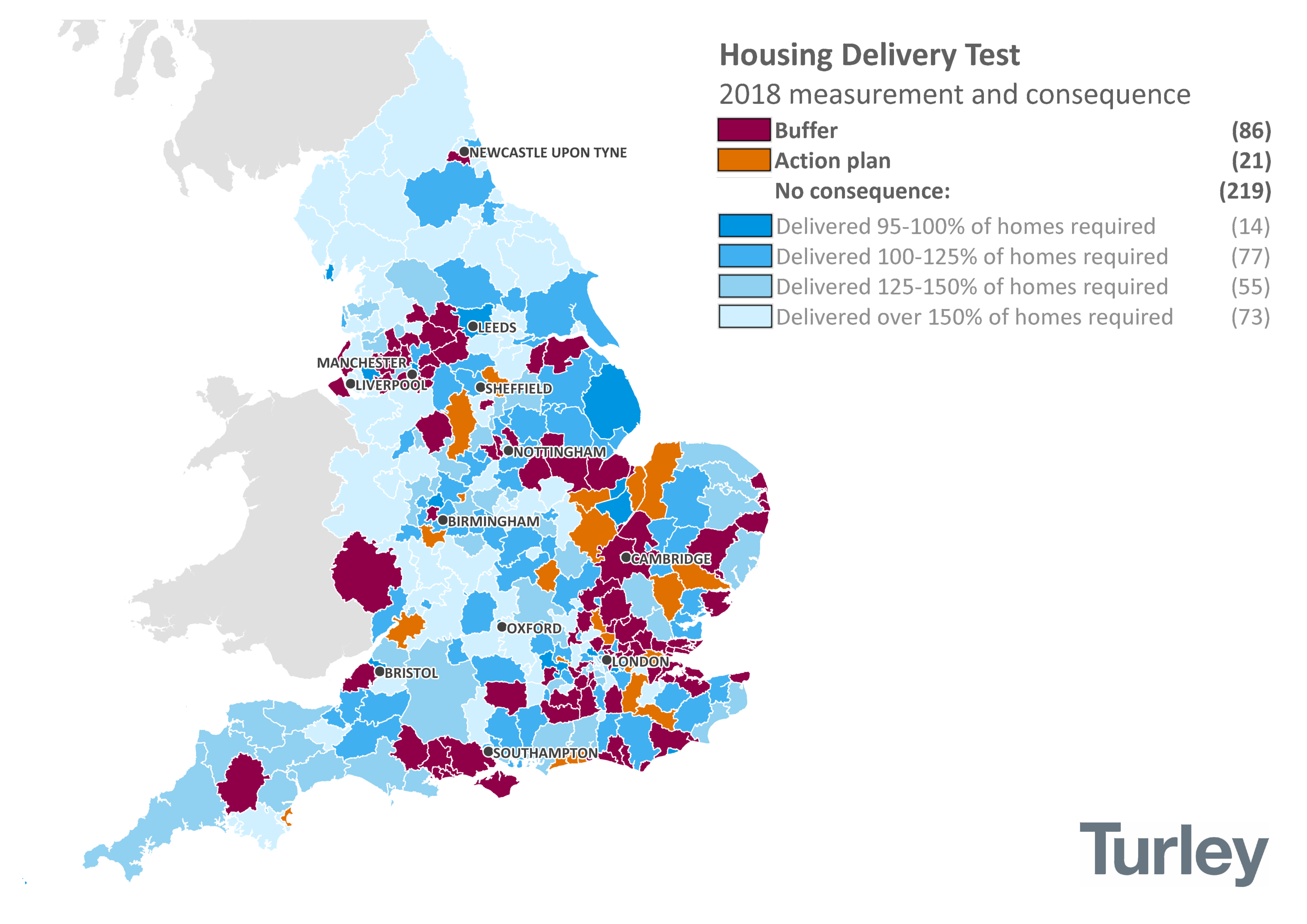Comment
Method after the madness
NPPF and calculating housing need
On 19 February 2019, Ministry of Housing, Communities and Local Government (MHCLG) published:
- an updated National Planning Policy Framework (NPPF) (February 2019)
- a response to the consultation on the standard method for calculating housing need
- the first Housing Delivery Test results
Today, 20 February 2019, an update to the National Planning Policy Guidance (NPPG) has arrived, reflecting yesterday’s announcements and amending paragraphs 001, 004 to 018, 020, and including new paragraphs 028-034 regarding ‘Economic Need’.
The updated NPPF (February 2019)
This long expected update follows the consultation undertaken in October 2018 regarding proposed clarifications to national planning policy on housing land supply, the definition of “deliverable”, and appropriate assessment for habitats sites.
All other elements of the NPPF remain as per the July 2018 version.
In summary, the main changes are as follows:
- Amended footnote 37 adds new text to clarify that where housing need is used as the basis for assessing a five-year supply, it should be calculated using the standard methodology as set out in the practice guidance.
- Paragraph 177 now states that the presumption in favour of sustainable development does not apply where the plan or project is likely to have a significant effect on a habitats site, unless an Appropriate Assessment has concluded that there will not be an adverse effect. This update reflects the recent People Over Wind & Sweetman v. Coillte Teoranta (C-323/17) and other related cases, which were not reflected in the previous July 2018 version. The change consequently rectifies an issue which meant that due to the previous drafting of paragraph 177, sites with suitable mitigation were still excluded from the application of the presumption, which was not the intention of the policy.
- Annex 2 updates the definition of ‘local housing need’ and clarifies that a justified 'alternative approach', in accordance with paragraph 60, could be pursued in the context of plan-making - but removes the scope for such debates in the context of five year land supply cases.
- Following a number of recent appeal decisions, the definition of what constitutes a ‘deliverable’ site has been re-worded in Annex 2 in order to make its meaning clearer.
A ‘compare and contrast’ tool which shows the amendments made between the July 2018 and February 2019 versions of the NPPF can be seen here.
Government response on the standard method – certainty for development management, but a sticking plaster for plan-making
The Government’s response to its autumn consultation on the standard method provides a welcomed degree of certainty for the purposes of development management (Five Year Housing Land Supply). Despite only 36% of respondents agreeing with it, the Government has implemented a ‘quick fix’ which reverts to the 2014-based household projections.
Recognising the longer timescales involved in plan-making, however, the ‘quick-fix’ has not grappled with the ‘weaknesses’ in the method identified both by the MHCLG and the National Audit Office (NAO) in Planning for new homes (February 2019). These include an acknowledged reliance on trend-based projections, which have proven to be volatile and present a circularity in projecting forward need, and the “limited flexibility to reflect local circumstances”. The NAO confirmed that large parts of the country, primarily the north and midlands, have as a result seen a notable fall in ‘calculated need’. It is also important to acknowledge that the ‘fix’ still falls short of supporting the Government’s ambition to deliver 300,000 homes per annum. This is more of a sticking plaster then, than a solution to the shortcomings.
Plan-makers can take comfort in the Government’s confirmation that the current method must be viewed as the “starting point for the planning process”. For many parts of the south this provides a clear mandate to embrace higher targets and develop positive planning policies for housing. For other parts of the country, however, addressing the weaknesses identified by the NAO means that a revised method must work to establish more realistic, and higher, housing need figures. This is an important consideration in the generation of plans being produced in the context of the 2019 NPPF.
In our view there remain inherent issues with this approach. We face a further review in the next 18 months whilst the Government review the formula and the way it is set using National Statistics data with a view to establish a new approach that balances the need for clarity, simplicity and transparency for local communities with the Government’s aspirations for the housing market.
Wherever the review takes us we strongly agree that it must create certainty and support the Government’s aspirations to boost the supply of housing to 300,000 homes a year. A cursory glance at the ‘yo-yoing’ housing requirement figure debated in the on-going Guildford Local Plan Examination highlights that there must be a better way to plan for the new homes that the country needs.
Housing Delivery Test 2018 results
Using the July 2018 Housing Delivery Test Measurement Rule Book, the first results of the Housing Delivery Test have also been published. In summary:
- There are 21 authorities which now have to publish an action plan to identify how housing will be delivered.
- There are 87 authorities which face an additional 20% added to their five-year supply buffer.
- All other authorities pass the test and are as such not penalised.

Keep an eye on this page for updates concerning the NPPF and NPPG. Should you have any queries about the updated NPPF, please contact Tim Burden.
20 February 2019
